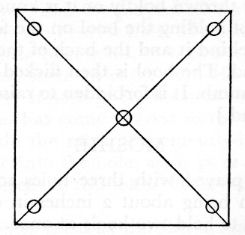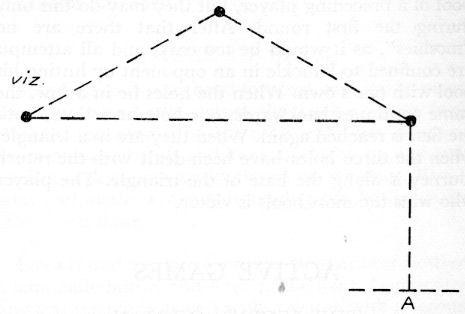|
Bools, as you must be
aware, is the Scotch for marbles (from the French, boule), and the
Scottish varieties, besides being large, differ in some respects from
those prevalent in England. Here are some of them.
DOBBLERS
Any number of players place
one bool each in a row, If the row is more than four or five, they may
make two or three rows, one behind the other. They fix their rotation by
whatever method suits them, generally by rolling towards a goal. Each
player in turn throws his plunker (Anglice, taw) and picks up as
many bools as he displaces. He leaves his plunker lying and subsequent
players may aim at it. Each time his plunker is hit he has to put a bool
into the row.
ONE-STEP
The bools are placed as
before. The range is larger. Each player takes one step and must throw his
plunker without pausing. He may either hit the bools direct or strike the
ground, bounce on to the wall behind and catch them in this way from
behind on the rebound. If he succeeds either way, he is entitled to throw
now from his new position in a stationary posture, i.e. without the
handicap of taking a step. But if his plunker strikes a bool from the wall
in the rear, the stroke does not count unless he shouts "Back licks"
before an opponent has time to shout "Nae back licks". This, besides
introducing a little characteristic metaphysics, avoids flukes.
TWO-STEPS
Same as One-Step,
but with a still longer range and taking two steps instead of one.
FIVE-O'S
A circle of about 18 inches
in diameter is described with heel or chalk and each player places a bool
within it; or, in the variant which gives the game its name, a square is
drawn and the bools are placed at the corners and centre at the discretion
of each player. In rotation each throws his plunker in an attempt to
dislodge one or more out of the base. Each bool knocked out be comes the
property of that player. Each plays his first throw from a fixed line and
subsequent throws from wherever his plunker has come to rest on the
previous throw. If the plunker comes to rest within the base, there it
must stay and be treated as one of those originally staked, and the player
who has forfeited it continues to play with another, if he has it. When
all the bools within the base have been won, the game goes on, the players
aiming at one another until one sole victor remains. But no player must
aim at an opponent's bool until the base is empty.
THREE-HOLEY
Three-Holey is the same as
Five-O's, except that the bools are arranged in three holes in a row. It
is more difficult to dislodge them from a hole or hollow than from the
level.
PLUNKERS
Plunkers is a simple
game-device for shortening a dull tract of road, such as the one to
school. Each throws his bool and the next player aims at it. Next again
aims at any bool ahead of him. Each bool struck is pocketed by the
striker, and the defeated has to put down another bool or retire.
SPANGY
Draw a diagram on the
ground thus:

A bool is placed by each
player in one of the positions indicated. If more than five play, other
bools may be placed at intervals along the marked lines. Players line up
about fifteen yards from the diagram. In turn they "knuckle" their taws as
described below, aiming at any one of the targets. Any bool knocked out of
the diagram is appropriated by the player. Each knuckles in turn and
leaves the taw lying. If he comes near enough a bool within the diagram he
may at his next turn attempt to capture it by "spanging", i.e. by placing
a thumb on his taw and a finger on the bool and knocking them together by
a sharp jerk; he must not draw them together. No bool may be knuckled
within the diagram; if a player cannot win the bool inside the diagram by
spanging, he must at his next turn return to the starting-line. But if he
fails in his attempt to win by spanging and yet leaves his taw within the
diagram, he may on his next turn make another attempt. Taws may be spanged
by opponents in any position within or outside the diagram, and in that
case the player whose taw has been spanged takes taw back to starting-line
and gives winner one bool.
[N.B. - It will be noted that we always talk
of "throwing" the bool or plunker. Any one of the games described can be
played by rolling instead of throwing or knuckling; but rolling in
Scotland is regarded as a pansy proceeding unworthy of the manly player.
The bool is either thrown boldly or it is knuckled. Knuckling consists of
holding the bool on the forefinger with the thumb behind it and the back
of the hand resting on the ground. The bool is then flicked forward by a
skite of the thumb. It is forbidden to raise the knuckles off the ground.]
MOSHIE
Moshie is played with three
holes scooped in the ground, each being about 2 inches in diameter and
deep enough to hold two boots at once. Some players arrange the holes in a
straight row with about an arm's-length between them: others prefer them
to define the points of an isosceles triangle of which the base would
measure a couple of arm's-lengths (or the outstretched arms from
finger-tips to finger-tips), while the sides would each measure an
arm's-length.

Whether the holes be in a
row or a triangle, the players - usually three in number - have their
stand opposite to the hold that is furthest to the right at about the same
distance from it as it is from the hole nearest to it (see A).
A bool is put in each hole
to begin with, each player contributing one, and the players all throw or
roll it turn, aiming at the nearest hole. If a player gets into the hole
the lying boot is his, to take out, but he doe: not immediately have an
extra shot. He merely cries, "I'm a moshie!" If none go in, the next round
is led by the player who has come nearest to the hole, and he tries to
knuckle the most conveniently-lying bool of another player into the hole,
not to go in himself. Any body who succeeds in this takes the potted bool
for his own.
The next round is led by
the player who went in his first shot into the hole, i.e. by the "moshie",
or failing this, by the first who knuckled in one of his opponents; and
the shots are played either from a line drawn through the first hole, or
from the standing position of a bool, the aim being the next nearest hole.
Players are allowed to cannon themselves in by striking the lying bool of
a preceding player, but they may do this only during the first round.
After that there are no "moshies", as it would be too easy, and all
attempts are confined to knuckle in an opponent by hitting his bool with
one's own. When the holes lie in a row, the game continues backwards, one
hole at a time, until the first is reached again. When they are in a
triangle, when the three holes have been dealt with the return journey is
along the base of the triangle. The player who wins the most bools is
victor. |
